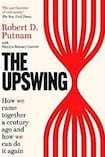
Celebrity social scientists are a rare species. Harvard professor Robert D Putnam described himself as an “obscure academic” until his scholarly paper on the decline of social capital in the United States was published in 1995. His elevation to celebrity status was confirmed when he was “invited to Camp David, lionised by talk-show hosts and pictured with his wife, Rosemary, on the pages of People”.
Putnam’s political guru credentials have since been recognised by, among others, former US presidents Bill Clinton, George W Bush and Barack Obama, and by our own former taoiseach, Bertie Ahern. His bestseller Bowling Alone, published in 2000, put on record the disappearance of social capital from the lives of American citizens. The proposition that ordinary citizens can create added social value from the raw material of their everyday relationships had never been so clearly expressed before. Social capital quickly became a panacea for all the ills of our times.
His main argument, that social capital – the positive connections among individuals and groups – is a truer measure of a society’s investment in its citizens wellbeing than economic capital, appealed to politicians seeking credibility as social reformers. Ahern described Putnam as “an extraordinary genius” and invited him to Ireland to address a Fianna Fáil party gathering in 2005.
Putnam has now co-authored The Upswing an evidence-based story of American history, social development and social capital accumulation spanning the past 125 years. And with Americans now mortally divided across political, social, racial, class, gender and ethnic lines, this is a timely publication. Putnam and Shaylyn Romney Garrett employ a wide-angle sociological lens to make clear how historical events and trends have come together to propel the US through different stages of individualism, collectivism and civic engagement.
Readable
What makes the book so readable is the use of narratives to support the statistical facts detailing the long upswing of American society – from the social Darwinism of the late 19th century to a more egalitarian, co-operative, cohesive and altruistic nation for two-thirds of the 20th century, to its reversion to a society once again dominated by toxic individualism.
This is not a dry, academic tome as much as a creative unfolding of the American experiment of promoting personal liberty while looking out for the common good. According to the authors, their book is about change and turning points in equality, polarisation, social solidarity and individualism, not about static levels.
Towards the latter-half of the 19th century, the pioneering impulses of Americans found expression through cultural myths of individualism, self-reliance, self-interest and a belief in meritocratic principles. For many citizens, these beliefs were important and life defining. They sustained the belief that the US was truly a land of opportunity.
According to the authors, the stark reality was that in the 1870s, 1880s and 1890s the US was startlingly similar to today. Inequality, political polarisation, social dislocation and cultural narcissism prevailed – all accompanied, as they are now, by unprecedented technological advances, prosperity and material wellbeing. Six decades of slow and uneven progress towards a fairer, more equal and socially-secure society followed, and by the middle of the 20th century the US was a more egalitarian, co-operative, cohesive and altruistic nation.
Decline
This progressive upswing began tapering off in the 1970s. Across a range of indicators, along multiple dimensions, the authors track the decline of economic equality, the increasing polarisation of politics and the ascent of cultural narcissism.
To support their core proposition that a progressive upswing in the 20th century was bookended by two periods of social and moral drift, the authors utilised advanced methods of data analysis to uncover a single, core marker of these transformations. An immense amount of social, economic and demographic data was gathered to provide answers to the following critical questions: over the past 125 years has America been moving toward greater or lesser economic equality; greater or lesser comity and compromise in politics; greater or lesser cohesion in social life; and greater or lesser altruism in cultural values?
These four key metrics were combined to provide an overview of the degree of individualism and collectivism to be found across political, social and cultural spectrums over the past 125 years. The authors dubbed the resulting meta-trend the “I-We-I” curve.
The late 19th-century culture being more focused on individualism and less interested in the common good corresponded to the first “I” period, while over the next six decades of the 20th century, the US became more of a “we” society before reverting back to an “I” society from the mid-1960s to the present day.
These trends are represented throughout the book as inverted U diagrams that provide a data-rich portrait of how American society broke free from the shackles of narrow individualism, realised the benefits of greater communitarian living and slid back into the negative grasp of individualism once more.
The key message of the book is that true moral and cultural reform must be a “we” effort. Our current problems are mutually reinforcing and their solutions must be as well. Rather than siloed reform efforts competing for resources, the successful engineering of another American upswing will require immense collaboration.
Arguing for gradualist reform is a long game – reforms to undo the damage to the social fabric from deepening inequality, polarisation in cultural and conventional politics and narcissism – the authors call for a civic revival through active citizenship measures, which build coalitions of grass-roots, issue-based resistance and reform movements.
The Upswing ends with two cautionary notes. First, the authors advise against a populist over-correcting of selfish, hyper-individualism by imposing hyper-communitarianism and advising instead to fashion slow and steady reforms as an alternative to calls for revolution. Second, they urge never compromising on equality and inclusion. Segregation, white nationalism and sexism were rife during the progressive decades of the 20th century and limited membership to the widening circle of “we”.
This is an ambitious book, impressively written, easy to read, meticulously researched and imbued throughout with the authors’ concern for the fate of their country.
















